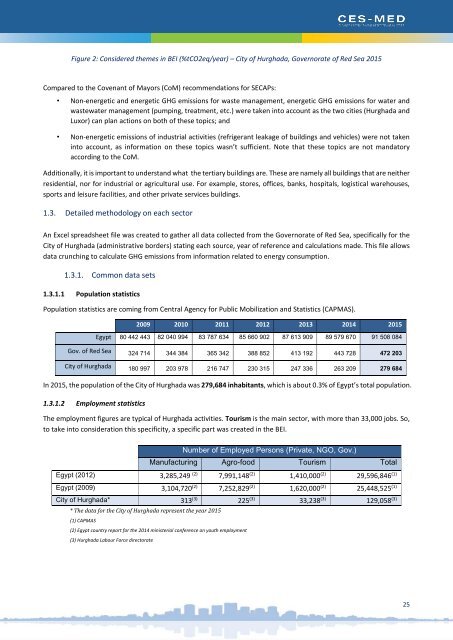020318_Hurghada SECAP_FINAL
Create successful ePaper yourself
Turn your PDF publications into a flip-book with our unique Google optimized e-Paper software.
Figure 2: Considered themes in BEI (%tCO2eq/year) – City of <strong>Hurghada</strong>, Governorate of Red Sea 2015<br />
Compared to the Covenant of Mayors (CoM) recommendations for <strong>SECAP</strong>s:<br />
• Non-energetic and energetic GHG emissions for waste management, energetic GHG emissions for water and<br />
wastewater management (pumping, treatment, etc.) were taken into account as the two cities (<strong>Hurghada</strong> and<br />
Luxor) can plan actions on both of these topics; and<br />
• Non-energetic emissions of industrial activities (refrigerant leakage of buildings and vehicles) were not taken<br />
into account, as information on these topics wasn’t sufficient. Note that these topics are not mandatory<br />
according to the CoM.<br />
Additionally, it is important to understand what the tertiary buildings are. These are namely all buildings that are neither<br />
residential, nor for industrial or agricultural use. For example, stores, offices, banks, hospitals, logistical warehouses,<br />
sports and leisure facilities, and other private services buildings.<br />
1.3. Detailed methodology on each sector<br />
An Excel spreadsheet file was created to gather all data collected from the Governorate of Red Sea, specifically for the<br />
City of <strong>Hurghada</strong> (administrative borders) stating each source, year of reference and calculations made. This file allows<br />
data crunching to calculate GHG emissions from information related to energy consumption.<br />
1.3.1. Common data sets<br />
1.3.1.1 Population statistics<br />
Population statistics are coming from Central Agency for Public Mobilization and Statistics (CAPMAS).<br />
2009 2010 2011 2012 2013 2014 2015<br />
Egypt 80 442 443 82 040 994 83 787 634 85 660 902 87 613 909 89 579 670 91 508 084<br />
Gov. of Red Sea 324 714 344 384 365 342 388 852 413 192 443 728 472 203<br />
City of <strong>Hurghada</strong> 180 997 203 978 216 747 230 315 247 336 263 209 279 684<br />
In 2015, the population of the City of <strong>Hurghada</strong> was 279,684 inhabitants, which is about 0.3% of Egypt’s total population.<br />
1.3.1.2 Employment statistics<br />
The employment figures are typical of <strong>Hurghada</strong> activities. Tourism is the main sector, with more than 33,000 jobs. So,<br />
to take into consideration this specificity, a specific part was created in the BEI.<br />
Number of Employed Persons (Private, NGO, Gov.)<br />
Manufacturing Agro-food Tourism Total<br />
Egypt (2012) 3,285,249 (2) 7,991,148 (2) 1,410,000 (2) 29,596,846 (1)<br />
Egypt (2009) 3,104,720 (2) 7,252,829 (2) 1,620,000 (2) 25,448,525 (1)<br />
City of <strong>Hurghada</strong>* 313 (3) 225 (3) 33,238 (3) 129,058 (3)<br />
* The data for the City of <strong>Hurghada</strong> represent the year 2015<br />
(1) CAPMAS<br />
(2) Egypt country report for the 2014 ministerial conference on youth employment<br />
(3) <strong>Hurghada</strong> Labour Force directorate<br />
25

















